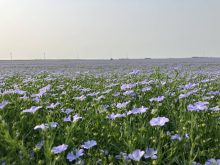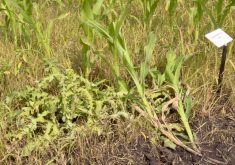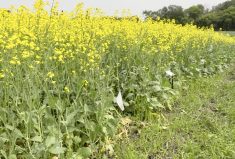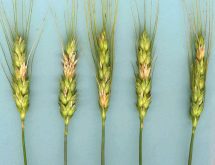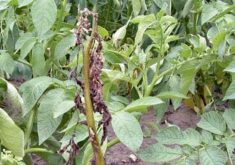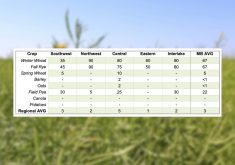If you grow flax in Manitoba, it will have pasmo.
The fungal disease, also known as Septoria linicola, can be found in every western Canadian flax field, every year. But the severity varies, making it tricky for farmers to decide whether to apply a fungicide, says Rachel Evans, the Flax Council of Canada’s extension agronomist.
“We’ll see anywhere from five to 30 per cent yield loss (from pasmo),” Evans said in an interview during the Crop Diagnostic School at the University of Manitoba’s Carman research station July 5. “But in severe cases it can be much higher than that.”
Read Also

CUSMA access key among other trade noise: Seeds Canada panel
Seeds Canada conference panelists say Canada needs to stay focused and wait as U.S. trade and tariff chaos develops, and a Canada-U.S.-Mexico Agreement review looms
Pasmo scouting should start at the seedling stage when the flax is about four inches high until flowering, Evans said.
Early symptom
Brown lesions on flax leaves are an early symptom. That can lead to leaves turning yellow and dropping making early detection important, she said.
“Under more severe cases of pasmo… spores will move onto the stem of the plant and then you’ll see the banding show up and that will be the really obvious symptom of pasmo,” Evans said.
That happens in mid-August. Then infection can move up the plant, infecting the pedicels — branches that hold the flax seed bolls. That can result in the bolls falling from the plant, cutting yields.
It can also result in lodging.
Two fungicides — Headline EC (pryaclostrobin) and Priaxor (fluxapyroxad and pryaclostrobin) — are registered to control pasmo in flax.
Both products are recommended for application at the early- to late-bloom stage, Evans said.
“What we recommend to growers is to be out early in the morning looking for their first flowers in their flax fields and then counting seven to 10 days after those first flowers show up,” she said. “Keep in mind that those flowers do drop off in the afternoon so going in the morning is going to be important.”
Fungicides effective
Fungicides are effective in controlling pasmo and can easily pay for themselves depending on the price of flax, the price of the fungicide and the severity of the disease, Evans said.
For example, if applying a fungicide increases yield 10 per cent in a field averaging 24 bushels an acre, that’s an extra 2.4 bushels an acre. If flax is earning $11 a bushel that’s an extra $26 an acre in revenue, she said.
But there are currently no yes-no tools to help farmers predict the potential severity of a pasmo infection, because some of the factors, such as future weather, are also variable, Evans said.
“Farmers should be considering their crop history and if flax has been grown before or in their area,” she said. “They should be considering environmental conditions. Has it been dry? Has it been wet and humid? (Wet and humid conditions can make pasmo worse.) They should be scouting. Are there symptoms showing up early in the season because then you are predisposed to having those symptoms move through and having an effect later.”
If a fungicide is applied, check treated fields one to two weeks later, especially if there have been frequent rain showers and warm weather during flowering.
If lesions are observed on new growth, consider making another fungicide application, the Flax Council of Canada website recommends.
To delay pasmo developing resistance, the second application should be a fungicide with a different mode of action, Manitoba Agriculture’s Guide to Field Crop Protection says.
To best manage pasmo, farmers should take an integrated approach, Evans said. Fungicides are just one tool, which should be used along with other measures such as planting disease-free seed.
“Seeding early can be beneficial,” she said. “That’s because you are avoiding some of those hot, humid conditions later in the season when the bolls are forming…
“Crop rotation is probably going to be the most important line of defence because our primary source of inoculum with pasmo is infected straw so maintaining a crop rotation of at least three years is going to be very important. Weed control, although flax benefits from good weed control regardless, it also keeps the humidity in the stand down and so that prevents good conditions for the disease to move around from the soil surface up on the leaves and stem into the boll.”
The 10-year Manitoba flax yield is 22 bushels an acre and has been for years. Pasmo is believed to be one of the reasons yields have plateaued.
Some research is being done into applying a fungicide earlier to control pasmo, Lionel Kaskiw, Manitoba Agriculture’s farm production specialist in Souris, said during the July 26 CropTalk Westman webinar.
But pasmo isn’t the only factor. Often flax is an afterthought and doesn’t get the same attention as other crops.
Last year flax averaged 22.5 bushels an acre on almost 60,000 of crop insured acres Manitoba Agricultural Services Corporation data shows. But in the RM of Roland, where 1,253 acres of insured flax were grown, the average yield was 38 bushels an acre — 69 per cent higher than the provincial average








